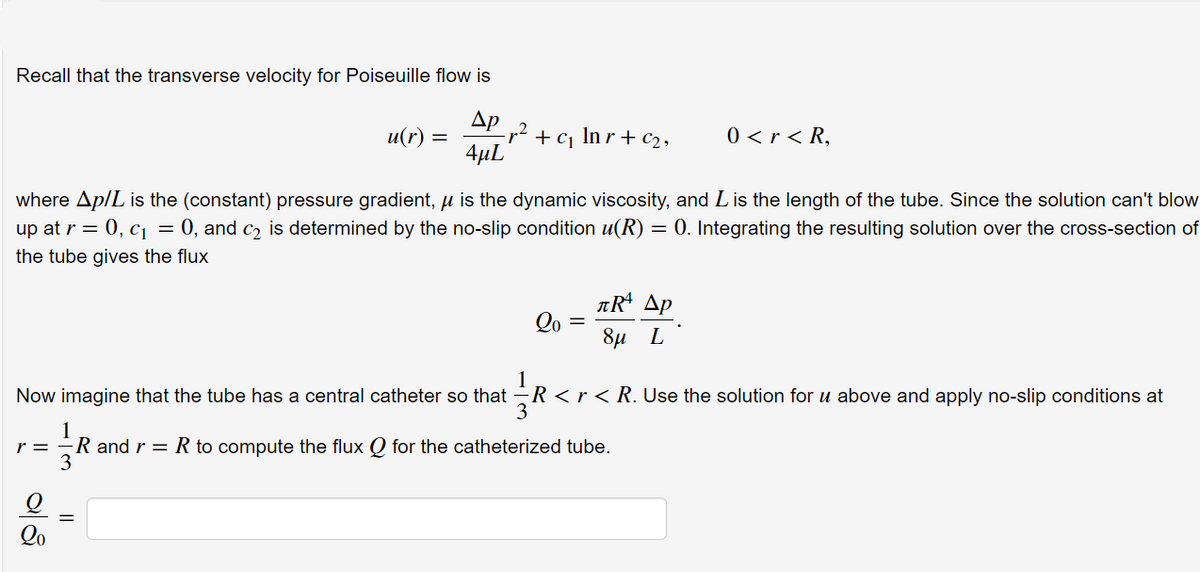Recall that the transverse velocity for Poiseuille flow is Др u(r) + cj In r + c2 , 0 < r < R, 4µL where Ap/L is the (constant) pressure gradient, µ is the dynamic viscosity, and Lis the length of the tube. Since the solution can't blow up at r = 0, c = 0, and c2 is determined by the no-slip condition u(R) = 0. Integrating the resulting solution over the cross-section of the tube gives the flux ARª Ap Qo 8µ L Now imagine that the tube has a central catheter so that -R
Recall that the transverse velocity for Poiseuille flow is Др u(r) + cj In r + c2 , 0 < r < R, 4µL where Ap/L is the (constant) pressure gradient, µ is the dynamic viscosity, and Lis the length of the tube. Since the solution can't blow up at r = 0, c = 0, and c2 is determined by the no-slip condition u(R) = 0. Integrating the resulting solution over the cross-section of the tube gives the flux ARª Ap Qo 8µ L Now imagine that the tube has a central catheter so that -R
Elements Of Electromagnetics
7th Edition
ISBN:9780190698614
Author:Sadiku, Matthew N. O.
Publisher:Sadiku, Matthew N. O.
ChapterMA: Math Assessment
Section: Chapter Questions
Problem 1.1MA
Related questions
Question

Transcribed Image Text:Recall that the transverse velocity for Poiseuille flow is
Др
u(r)
+ cj
In r + c2 ,
0 < r < R,
4µL
where Ap/L is the (constant) pressure gradient, µ is the dynamic viscosity, and Lis the length of the tube. Since the solution can't blow
up at r = 0, c = 0, and c2 is determined by the no-slip condition u(R) = 0. Integrating the resulting solution over the cross-section of
the tube gives the flux
ARª Ap
Qo
8µ L
Now imagine that the tube has a central catheter so that -R <r < R. Use the solution for u above and apply no-slip conditions at
r = -R and r = R to compute the flux Q for the catheterized tube.
3
Qo
Expert Solution
Step 1
The cross-section of the tube gives the expression for flow
Now for we have
So
Step by step
Solved in 2 steps

Recommended textbooks for you

Elements Of Electromagnetics
Mechanical Engineering
ISBN:
9780190698614
Author:
Sadiku, Matthew N. O.
Publisher:
Oxford University Press

Mechanics of Materials (10th Edition)
Mechanical Engineering
ISBN:
9780134319650
Author:
Russell C. Hibbeler
Publisher:
PEARSON

Thermodynamics: An Engineering Approach
Mechanical Engineering
ISBN:
9781259822674
Author:
Yunus A. Cengel Dr., Michael A. Boles
Publisher:
McGraw-Hill Education

Elements Of Electromagnetics
Mechanical Engineering
ISBN:
9780190698614
Author:
Sadiku, Matthew N. O.
Publisher:
Oxford University Press

Mechanics of Materials (10th Edition)
Mechanical Engineering
ISBN:
9780134319650
Author:
Russell C. Hibbeler
Publisher:
PEARSON

Thermodynamics: An Engineering Approach
Mechanical Engineering
ISBN:
9781259822674
Author:
Yunus A. Cengel Dr., Michael A. Boles
Publisher:
McGraw-Hill Education

Control Systems Engineering
Mechanical Engineering
ISBN:
9781118170519
Author:
Norman S. Nise
Publisher:
WILEY

Mechanics of Materials (MindTap Course List)
Mechanical Engineering
ISBN:
9781337093347
Author:
Barry J. Goodno, James M. Gere
Publisher:
Cengage Learning

Engineering Mechanics: Statics
Mechanical Engineering
ISBN:
9781118807330
Author:
James L. Meriam, L. G. Kraige, J. N. Bolton
Publisher:
WILEY